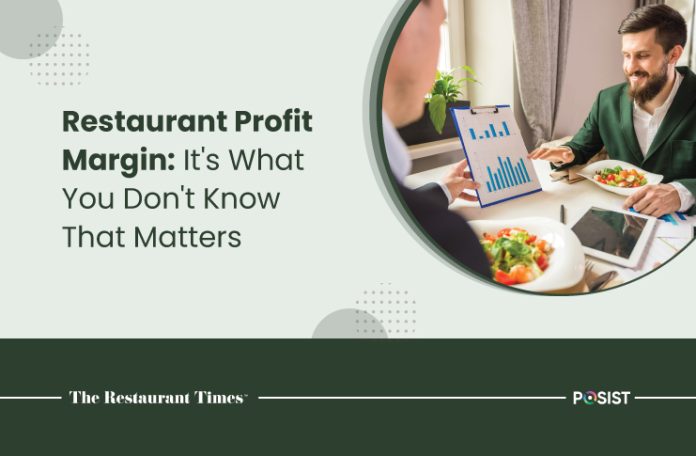Making enough money to keep your restaurant running is one of the major challenges a restaurant faces. For this reason, the profit margin of your restaurant is one of the defining factors of its success.
It is well known that the hospitality sector has lower profit margins than other market segments. In fact, according to reports, the net profit margins across the restaurant industry decreased from 16% in Q2 2021 to 9.59% in Q2 2022.
That said, with the right strategies, your restaurant can be an exception and report high-profit margins. In this article, we’ll cover all the basics of a restaurant’s profit margin – meaning the average profit margin of different restaurants and how to increase your restaurant’s profit margin. Read along!
How To Calculate Restaurant Profit Margin?
As opposed to profit, which is demonstrated as a dollar amount, your restaurant’s profit margins are its profits represented as a percentage of annual sales. Your profit margins should be as high as possible.
There are two ways to calculate the profit margins of a restaurant – gross profit margin and net profit margin.
The gross profit margin is left over after subtracting the cost of the goods sold. This includes expenses for things like food and beverages. This can evaluate your restaurant’s overall business strategy and financial health.
Your net profit remains after operating costs like payroll, rent, utility costs, ingredient costs, and equipment leasing fees have been subtracted from your gross profit.
Here is the formula to calculate the gross and net profit margins:
Gross Profit Margin Formula
Gross profit margins are calculated using a fairly simple formula. Simply subtract your total sales from your cost of goods sold (CoGS) over a certain period. This data should be easily accessible from your restaurant’s point-of-sale (POS) system.
Total Sales – COGS = Gross Profit
Now, divide the gross profit by total sales to get the gross profit margin.
Gross Profit / Total Sales = Gross Profit Margin
Net Profit Margin Formula
To assess your restaurant’s net profit margin, begin by deducting all expenses from your gross revenue over a specific period, typically one year. Next, divide this amount by the overall revenue and multiply the result by 100 to determine your restaurant’s net profit margin percentage.
Gross Revenue – Overall Expenses = Net Profit
Net Profit / Gross Revenue = Profit Margin
Profit Margin X 100 = Restaurant’s Net Profit Margin Percentage
As opposed to your gross profit margin, your net profit margin gives a more accurate picture of your business’s performance. This is because your net profit margin accounts for all restaurant-related costs, not just those related to food preparation and service.
What Is The Average Profit Margin For Restaurants?
Just like a restaurant’s success is not entirely determined by the food or beverages it serves, the average profit margin for restaurants is influenced by various factors. Some of those factors include the type of restaurant and the average cost per customer.
Although it can range from 0 to 15%, the typical profit margin for restaurants is between 3 and 5%. This can be divided into the typical profit margin for each type of restaurant:
Quick-service restaurants (QSRs)
QSRs typically have higher profit margins than full-service restaurants, averaging between 6 and 9%. This is due to several factors, including fewer employees, increased sales, and more inexpensive ingredients.
However, most QSRs increasingly use online orders and delivery as a source of income, which comes at an additional cost.
Full-service restaurants (FSRs)
Due to their higher average costs compared to other establishments, FSRs generally have lower profit margins. Their menu prices also tend to be higher than those of other restaurant types because they have higher labor, overhead, and operational costs than other businesses.
When revenue to expenses are considered, profit margins for FSRs typically range between 3 and 5%.
Food trucks
Food trucks are becoming more well-known for using top-notch ingredients and offering gourmet dishes in an informal setting, even though operating out of the back of a truck comes with completely new costs — fuel, specialized licenses, and permits.
The typical profit margin of a food truck ranges from 6 to 9% thanks to low overhead costs that offset more expensive ingredients.
Catering
Catering businesses, like food trucks, profit from low overhead expenses but have food costs similar to FSRs. The typical profit margin for a high-end catering business is 15% or more.
How To Increase Your Restaurant Profit Margin?
You can approach this issue in two ways: by boosting sales volume and by lowering overhead costs. Having said that, it’s also critical to remember that, as with almost everything else, what helps one restaurant may not necessarily help another.
Therefore, it is essential to plan ahead. Setting realistic restaurant goals will help you overcome unforeseen events, such as bad weather and recessions. Here are some more tips on how to increase your profit margin:
1. Increase Sales Volume
You must boost your sales revenue to increase your restaurant’s profit margin. Although some elements, such as labor, COGS, or overhead, are beyond your direct control, some ways to boost productivity and sales still exist. Some of those are:
- Optimize Menu Pricing: Optimizing menu prices is a quick and easy way to raise profit margins at your restaurant. For a typical restaurant to operate profitably, the food cost percentage must be between 28% and 35%. If this percentage exceeds 28-35%, you are underpricing those items and should increase your prices.
- Train Employees: The skill of upselling to customers distinguishes a good server from a great one. The secret to increasing revenue in your restaurant has skilled waitstaff who can suggestively sell food and drinks. Servers use suggestive selling to encourage guests to order menu items they hadn’t considered to increase their overall sales.
- Improve Table Turnover: Table turnover is customers’ time at a table in your restaurant from arrival until they leave. The more clients you serve for each service, the more profit you stand to make. The best way to achieve this is by equipping the front and back-of-house (BOH) staff with efficient tools such as a kitchen display system (KDS) and a point of sale (POS) system.
2. Lowering Overhead Costs
Next, you can increase your profit margins by lowering recurring costs like labor and overhead. Here are some of the best ways to lower your restaurant’s overhead costs:
- Minimize Food Waste: As a restaurant owner, you already know how much money food bills take out of your budget, meaning that if the food gets spoiled, the sunk cost can seriously reduce your profit margins. According to a report, restaurants are expected to lose about $1.5 trillion in revenue due to food waste by 2030. Therefore, we advise adopting a serious inventory management strategy, particularly for perishable, expensive ingredients like meat and fish, to ensure that you only purchase as much as you can sell before spoilage happens.
- Reduce Utility Bills: Did you know that, compared to other commercial buildings, restaurants typically use five to seven times as much energy per square foot? It can be up to ten times more for QSRs. Therefore, investing in eco-friendly kitchen equipment and lighting can help reduce your utility costs, which will also increase your revenue. Although new restaurant equipment comes with an upfront cost, the equipment can help you save money over time by lowering your utility costs.
- Lower Employee Turnover: Training new staff takes time and money, which can affect your restaurant’s profitability. To improve employee retention, hold regular meetings, get their feedback, and work with them to build loyalty. You should also track your restaurant’s busiest times and days and adjust their schedule accordingly – you don’t want to have too many or too few staff at any point. To determine the busiest and quietest periods in your business, look at the sales reports of your POS system and adjust your staff schedule accordingly.
Conclusion
For your restaurant business to be successful, you need to have a high-profit margin. Having said that, no one method of raising profit margins is effective in every restaurant’s situation.
Instead, you should think like a detective and find all the information that will give you a complete picture of your sales and expenses to increase profit margins. Additionally, determine your restaurant’s vision and objectives and decide which strategies will work best.

















